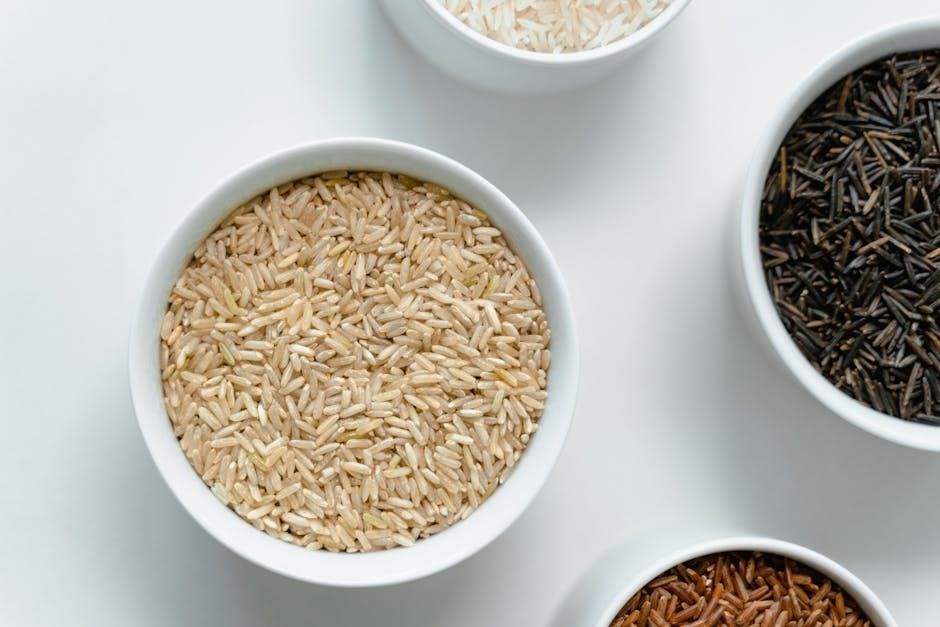Cuckoo offers diverse rice cooker models, from basic to advanced, including electric pressure and induction heating types. Models like CRP-DHSR0609F boast LED displays and stainless steel pots. Manuals are available for download as PDFs, providing instructions and safety warnings.
Overview of Cuckoo Rice Cooker Models
Cuckoo rice cookers come in various models, each designed with specific features and technologies to cater to diverse cooking needs. From basic models ideal for simple rice preparation to advanced multi-functional cookers, Cuckoo offers a comprehensive range. Electric pressure rice cookers, like the CRP-RT0609F and CRP-P1009S, utilize pressurized cooking for faster, more even results, perfect for those who prioritize efficiency and taste.
Induction heating (IH) models, on the other hand, employ advanced heating technology for precise temperature control and superior cooking performance. These models often come with pre-set functions for various types of rice, including white rice, brown rice, and GABA rice, ensuring optimal results every time. The Cuckoo CRP-CHSS1009FN, for example, boasts a stainless steel pot, recipe book, and steaming basket, making it a versatile kitchen appliance.
Whether you’re a sushi enthusiast or simply looking for a reliable rice cooker, Cuckoo has a model to suit your needs. User manuals are readily available online, providing detailed instructions on operation, maintenance, and troubleshooting.

Understanding Your Cuckoo Rice Cooker
Key Features and Technologies
Cuckoo rice cookers are renowned for their innovative features and technologies designed to enhance cooking performance and user experience. One key feature is the pressurized cooking system, found in models like the CRP-P1009, which ensures even heat distribution and faster cooking times. This technology is particularly beneficial for achieving the perfect texture and flavor in rice.
Many Cuckoo rice cookers also incorporate induction heating (IH) technology, offering precise temperature control and consistent results. IH models often feature pre-set cooking functions for various types of rice, allowing users to easily cook different grains to perfection. Additionally, Cuckoo rice cookers often come equipped with user-friendly LED displays, making it easy to monitor cooking progress and adjust settings.
Other notable features include durable stainless steel inner pots, non-stick coatings, and built-in safety mechanisms. Some models even offer smart features like voice guidance and automatic keep-warm functions. These advanced technologies and thoughtful design elements make Cuckoo rice cookers a popular choice for home cooks seeking quality and convenience.
Upon unboxing, identify all components: the rice cooker, inner pot, measuring cup, and accessories like the steaming basket and soup scoop. Consult the manual for a detailed parts list and familiarize yourself with each component’s function before first use.
Unboxing and Component Identification
Upon receiving your Cuckoo rice cooker, carefully unbox it and identify all the included components. Typically, you’ll find the main rice cooker unit, a non-stick inner pot (often made of stainless steel), a measuring cup for accurate rice measurement, and a rice spatula or scoop for serving.
Depending on the model, you may also find additional accessories such as a steaming basket for cooking vegetables or other foods simultaneously, a soup scoop for serving soups or stews, and a recipe book offering various cooking suggestions and guidelines specific to your Cuckoo rice cooker.
Refer to the user manual for a comprehensive list of all components and their corresponding functions. Familiarize yourself with each part, understanding its purpose and how it interacts with the rice cooker. This will ensure proper usage and maintenance, prolonging the lifespan of your appliance and guaranteeing optimal cooking performance.
The manual will also provide diagrams or illustrations to help you visually identify each component, especially if certain parts are unfamiliar or have unique features. Proper identification is crucial for following instructions correctly and avoiding any potential damage or misuse of the rice cooker.

Initial Setup and Operation
First-Time Use Instructions
Before using your Cuckoo rice cooker for the first time, it’s essential to follow these instructions. Begin by thoroughly washing the inner pot with warm, soapy water and drying it completely. This removes any manufacturing residues. Next, familiarize yourself with the control panel and its various functions.
Place the cleaned and dried inner pot into the rice cooker. Measure the desired amount of rice using the provided measuring cup, and rinse the rice several times until the water runs clear. Add the appropriate amount of water according to the rice type and your preferred consistency. Refer to the manual for specific water-to-rice ratios.
Close the lid securely, ensuring it’s properly sealed. Select the appropriate cooking function from the control panel, such as “White Rice,” “Brown Rice,” or another preset option. Press the “Start” button to begin the cooking process. The rice cooker will automatically cook the rice and switch to “Keep Warm” mode once finished.
After cooking, allow the rice to steam for about 10-15 minutes before opening the lid. Use the provided rice spatula to fluff the rice and serve. Always unplug the rice cooker after use and allow it to cool down before cleaning.

Cooking with Your Cuckoo Rice Cooker
Cuckoo rice cookers excel at preparing various rice types. Adjust water ratios based on the rice. For sushi rice, aim for chewy, distinctive grains. Refer to your manual for precise cooking instructions and optimal results every time.
Cooking Different Types of Rice
Your Cuckoo rice cooker isn’t just for white rice; it’s capable of cooking a wide array of rice varieties, each with its unique characteristics and optimal cooking methods. Understanding these nuances is key to unlocking the full potential of your appliance and enjoying perfectly cooked rice every time.
For white rice, the standard recipe involves rinsing the grains until the water runs clear, then adding the appropriate amount of water as indicated in your manual. However, brown rice requires more water and a longer cooking time due to its bran layer. Some Cuckoo models even have a dedicated brown rice setting to automate this process.
Sushi rice demands a specific texture: chewy and slightly sticky. Experiment with water levels to achieve this desired consistency. GABA rice, another option, might require a special setting or cooking cycle to maximize its nutritional benefits.
Always consult your Cuckoo rice cooker manual for specific instructions tailored to your model and the type of rice you’re cooking. The manual often provides recommended water ratios, cooking times, and preset functions to ensure optimal results. Remember that practice makes perfect, so don’t be afraid to experiment until you find your preferred settings.
Using Preset Cooking Functions
Cuckoo rice cookers often come equipped with a range of preset cooking functions designed to simplify the preparation of various dishes. These presets take the guesswork out of cooking, automatically adjusting the temperature and cooking time for optimal results. Understanding and utilizing these functions can greatly enhance your cooking experience.
Common presets include options for white rice, brown rice, porridge, sushi rice, and even multi-grain rice. Some models also offer specialized functions for dishes like congee, soups, and stews. To use a preset function, simply select the desired option on the control panel and press start. The rice cooker will then automatically manage the cooking process, alerting you when the dish is ready.
It’s important to consult your Cuckoo rice cooker manual for a complete list of available presets and their specific applications. The manual will also provide guidance on adjusting the settings for each preset to suit your personal preferences. For example, you might want to increase the cooking time for brown rice to achieve a softer texture.
Experiment with different presets to discover new ways to use your Cuckoo rice cooker and expand your culinary repertoire. With a little practice, you’ll be able to create a wide variety of delicious and healthy meals with ease.
Proper maintenance ensures longevity. Regularly clean the inner pot, steam vent, and condensation collector. Refer to the manual for specific cleaning instructions and approved cleaning agents. Timely addressing problems prevents major issues and guarantees ongoing efficient functionality.
Cleaning and Care Instructions
Maintaining your Cuckoo rice cooker is crucial for its longevity and optimal performance. Always unplug the rice cooker and allow it to cool completely before cleaning. The inner pot, often made of stainless steel or with a non-stick coating, should be washed with warm, soapy water using a non-abrasive sponge to avoid scratching the surface. Rinse thoroughly and dry completely before placing it back into the cooker.
The steam vent and condensation collector require regular attention. The steam vent can be cleaned with a damp cloth to remove any food particles or residue that may accumulate. The condensation collector should be emptied and washed after each use to prevent bacterial growth and unpleasant odors. The exterior of the rice cooker can be wiped down with a damp cloth as needed.
Avoid immersing the entire rice cooker in water or using harsh chemicals or abrasive cleaners, as this can damage the electrical components and the exterior finish. Refer to your specific Cuckoo model’s manual for detailed cleaning instructions and any model-specific recommendations. Regular cleaning not only ensures hygiene but also contributes to the efficient operation and extended lifespan of your Cuckoo rice cooker.

Maintenance and Troubleshooting
Troubleshooting Common Issues
Encountering issues with your Cuckoo rice cooker can be frustrating, but many problems have simple solutions. If the rice cooker doesn’t turn on, ensure it’s properly plugged in and the outlet is functioning. If the rice is undercooked, try adding a little more water in the next batch. Overcooked rice might indicate too much water or an incorrect rice-to-water ratio. If the rice cooker displays an error code, consult your manual for specific troubleshooting steps related to that code.
If the rice sticks to the bottom of the pot, make sure to use the recommended amount of water and avoid opening the lid during the cooking process. If the steam vent is blocked, carefully clean it to ensure proper steam release. Unusual noises during operation could indicate a loose component or a problem with the pressure mechanism; in such cases, professional servicing is recommended.
Always refer to your Cuckoo rice cooker manual for detailed troubleshooting guidance specific to your model. For persistent or complex issues, contacting Cuckoo’s customer support or an authorized repair center is advisable to prevent further damage and ensure safe operation. Regular maintenance and prompt attention to minor issues can help prevent major problems in the long run.